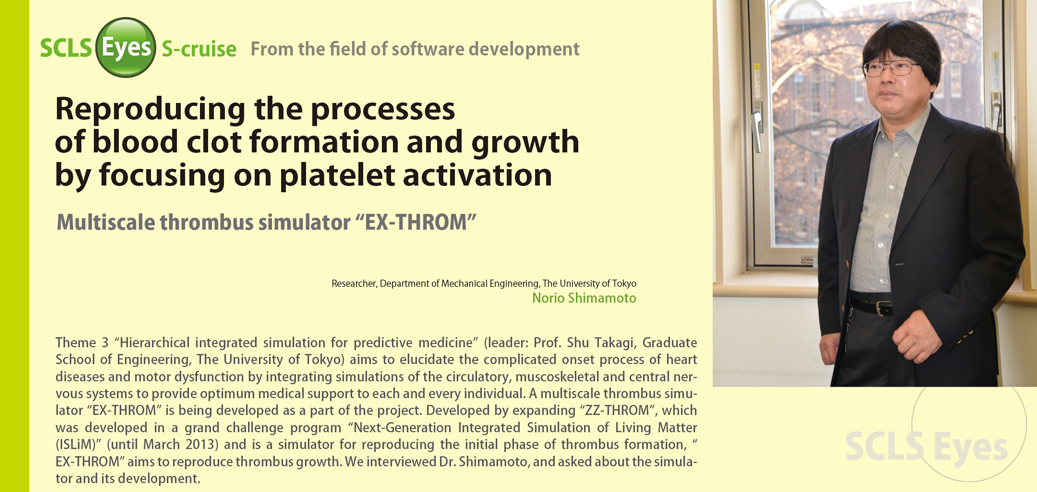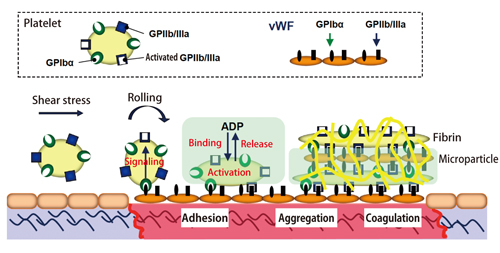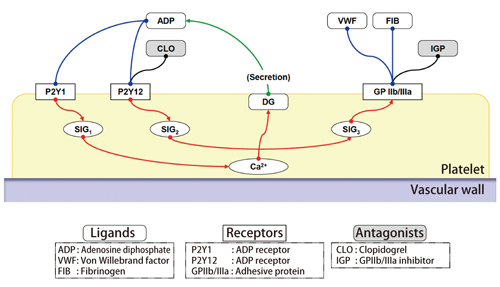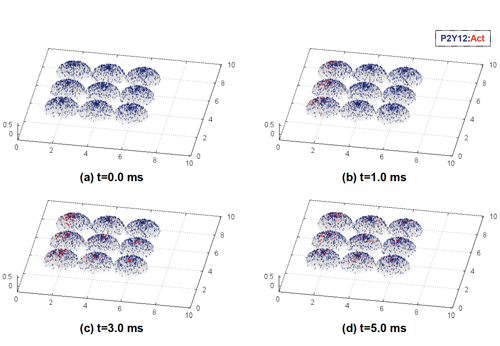

Fig. 1:Mechanism of thrombus formation. Von Willebrand factor (vWF) in the damaged vascular endothelium binds with protein GPIbα present on a platelet, resulting in the platelet adhesion. When the platelet is activated by a signal transduction of stimulus, it releases ADP, inducing further activation of itself and other platelets, and the procedure to advance to aggregation and coagulation.
Modification of an illustration cited from Platelet Biology (in Japanese) edited by Ikeda and Maruyama (Medical Review Co., Ltd.)

Fig. 2:Reaction model of platelet activation
Focusing on ADP stimulation in thrombus growth
━How does a thrombus actually form?
Shimamoto
The mechanism of thrombus formation is basically the same as that of blood coagulation at hemastasis, which is a defensive mechanism against damage to blood vessels. The coagulation system is an important response for maintaining life; but the blood clot may grow, hinder the flow of blood, block up a vessel and cause ischemia or infarction. This is called thrombosis.
Platelets play the key role in thrombus formation. When a vascular wall is damaged due to some reason, it triggers von Willebrand factor (vWF) on the wounded site to bind with protein GPIbα on a platelet, resulting in the platelet adhering to the vessel wall. The activated protein GPIIb/IIIa present on the platelet binds with vWF and fibrinogen, and causes the platelet to successively adhere with other platelets and a platelet thrombus, which is an aggregate of platelets, to form. Then, a series of multistage chain reactions by 12 blood coagulation factors takes place. During the process, a network structure called fibrin mesh is formed and entraps blood cells such as erythrocytes, making the thrombus to grow further and a stable “fibrin clot” to be formed.
━Your team is developing EX-THROM. What kind of application software is it?
Shimamoto ZZ-THROM, which is a multisimulator for reproducing the initial phase of thrombosis, was developed in the grand challenge program based on a new fluid-structure coupling method (ZZ-EFSI). It reproduces the processes of platelet adhesion on a damaged vascular wall. We are now developing EX-THROM, which is a multiscale thrombus simulator, to reproduce the activation process of adhered platelets and the subsequent thrombus formation processes by expanding the functions of ZZ-THROM. A number of substances are involved in thrombus formation compositely and at various stages. The processes are still not fully understood. To develop the thrombus simulator, we need to incorporate minute reactions, but we are thinking of narrowing targets first, creating a framework that reproduces the characteristic movements of platelets, and then moving into minute reactions.
━What are the important targets for building the framework?
Shimamoto During the processes of platelet aggregation, platelet-inducing substances, which binds with receptors on the platelet surface and stimulate and promotes activation of the platelet, play important roles. Adenosine diphosphate (ADP) is one of such substances. It has been experimentally revealed that platelets aggregate and dissociate depending on ADP concentration. Activated platelets release ADP contained in dense granules, and the “ADP positive feedback mechanism”, which is a chain reaction that amplifies activation, occurs. Therefore, we are focusing on and modeling the activation of platelets by ADP, which is a key process in platelet aggregation. In concrete terms, we are reproducing the activation of GPIIb/IIIa, which is induced by ADP binding to ADP receptors P2Y12 and P2Y1 and subsequent activation reactions. Using this model, we are going to investigate how the activations of P2Y12 and GPIIb/IIIa on the platelet surface undergo time sequential changes in a condition where ADP, vWF and fibrinogen diffuse advectively and undergo concentration changes. Obviously, ADP alone does not stimulate the entire process. Various substances are involved in an integrated manner. We will be expanding the functions of the model by adding their involvement.
We also aim to use the model to evaluate a thrombosis therapeutic agent
━What are the important points in modeling?
Shimamoto The important point is to well reproduce the characteristics of the actual phenomena. There are many substances involved; but if we incorporate them all blindly, we would not be able to understand what is happening. On this point, we are receiving advice from Professor Shinya Goto of Tokai University School of Medicine, who is a specialist in thrombosis, as well as other specialists. We are going to create a model consistent with experimental data by also including the reactions of thrombin, serotonin and thromboxane A2 as well as ADP stimulus.
━We have heard that your study project also aims to use the model to evaluate a thrombosis therapeutic agent.
Shimamoto Yes. We are now investigating clopidogrel, which blocks P2Y12 of the ADP receptor and inhibits binding, and an inhibitor of GPIIb/IIIa, which binds platelets together.

Fig. 3:Calculation example of P2Y12 activation. During the time course in which ADP undergoes advective diffusion, the P2Y12 molecules on the surface of the platelets bind with ADP, and deactivated molecules (blue) become activated (red).
━Have you already obtained the computation results from the K computer?
Shimamoto We are still in the phase of testing calculation. Actual calculation using the K computer will be the next step. We will be calculating the process of platelet activation inter-connectedly with blood flow calculation including erythrocytes, which was developed in ZZ-THROM.
━What was the most difficult point in modeling?
Shimamoto I am originally from an engineering school, and had difficulty understanding the medical information. Moreover, much is left unveiled in the mechanism of thrombus formation. It is also difficult deciding how to refine the model. At present, I’m trying to improve the model so as to fit the knowledge that has experimentally been acquired by Prof. Goto and his team of medical specialists by continuously giving feedback.
━Please tell us about your prospects.
Shimamoto We have just advanced from the stage of aggregation to the stage of coagulation. We are now also investigating coagulation. Our goal is to reproduce the actual process of thrombus formation. We also aim to contribute to evaluation of a thrombosis therapeutic agent. For example, if we can reveal how much should be administered and at which timing of thrombus formation by simulation, we would be able to contribute to thrombosis treatment.
 |
 |
 |
 |
 |
|---|











